
The Mandate of the HAZOP Facilitator in Process Safety Excellence: A Procedural and Ethical Analysis
Section 1: The Foundational Role, Standards, and Ethical Mandate
The role of the Hazard and Operability (HAZOP) facilitator is central to the efficacy and integrity of the entire risk assessment process in high-hazard industries. This individual serves as the procedural anchor, translating a collaborative, qualitative risk assessment method into a structured, auditable engineering process grounded in international best practices.
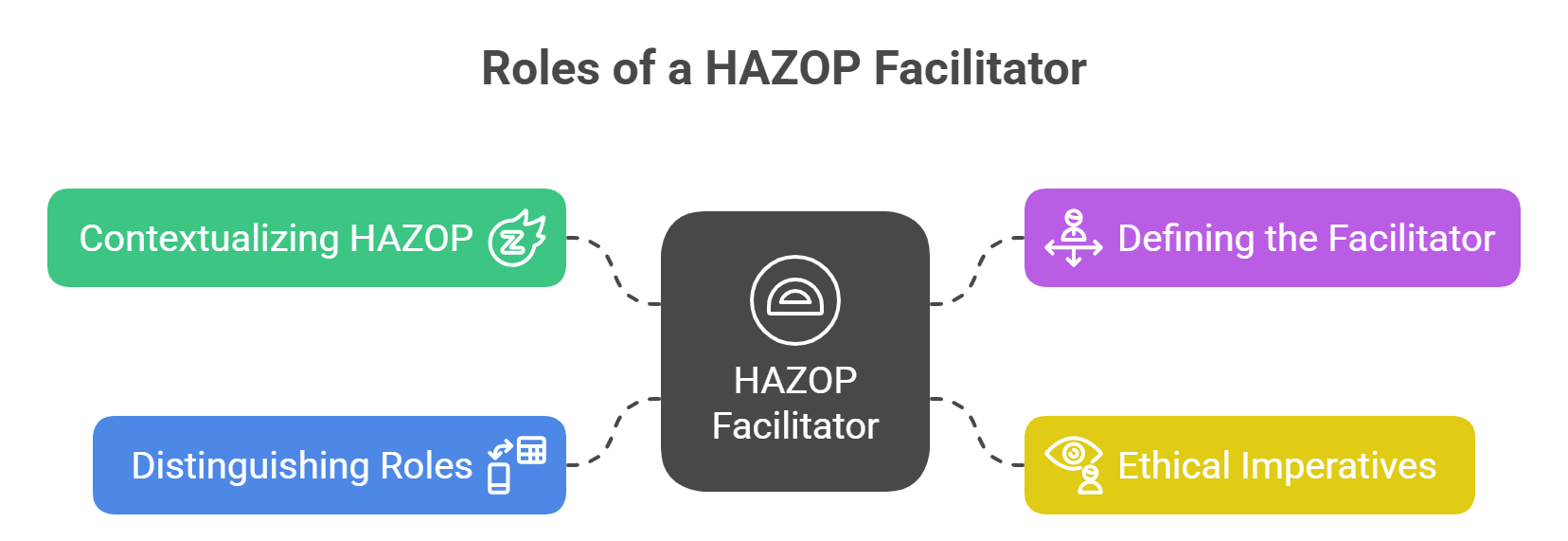
1.1. Contextualizing HAZOP within the Risk Management Framework (IEC 61882 and QRM)
HAZOP is formally defined as a structured and systematic technique for system examination and risk management. It functions as a qualitative, inductive, “bottom-up” brainstorming approach designed to identify potential hazards and operability problems that stem from deviations from the intended design or operating parameters. The identification of these deviations is systematically achieved through the use of guide words, which stimulate the creative thinking of the team members.
The methodology itself is codified in international standards, notably IEC 61882, the “Hazard and Operability Studies (HAZOP studies) Application Guide”. The facilitator must possess expert-level command of the HAZOP method and the underlying principles of risk management being applied. This methodological mastery is crucial because it ensures that the team rigorously follows sound, standardized procedures throughout the analysis. By enforcing strict adherence to recognized standards like IEC 61882, the facilitator guarantees that the output of the risk assessment is not merely a set of opinions, but a legally defensible and auditable engineering document.
1.2. Defining the Facilitator: Independence, Authority, and Accountability
The facilitator is officially designated as the coordinator and chairperson of the study. They function as the expert in risk management methodology and are responsible for fostering collaborative leadership within the cross-functional team. The effectiveness of the study is profoundly dependent upon the competence of this individual.
A cardinal requirement, recognized globally in process safety, mandates that the study must be chaired by a qualified person who is experienced in HAZOPs and is independent of the operator. This organizational separation is not arbitrary; it recognizes that project pressures, driven by financial or scheduling constraints, can introduce bias into the risk interpretation process. By assuming accountability for methodological fidelity and procedural structure, the facilitator maintains a critical distance from the design team’s inherent accountability for project delivery.
1.3. Ethical Imperatives: Guaranteeing Objectivity and Freedom from Bias
The core integrity of the HAZOP analysis rests upon the facilitator’s independence. True facilitation requires a distinct separation between the facilitator and individuals possessing a financial or design stake in the project. This separation mitigates two primary risks to the study’s objectivity: Financial or Project bias, where the facilitator might be influenced to avoid costly or time-consuming improvement suggestions; and Design bias, where proximity to the design leads the facilitator to overlook potential hazards or fail to challenge assumptions critically.
An independent facilitator provides all stakeholders with confidence that the recommendations generated are based exclusively on safety and good practice, rather than being skewed by internal constraints. To structurally support this necessary objectivity, project budgeting should include a separate line item specifically designated for HAZOP facilitation and reporting. This measure reinforces the facilitator’s role by removing any perceived financial leverage that could compromise an impartial view.
1.4. Distinguishing Roles: Facilitator vs. Scribe vs. Team Member (SME)
Effective HAZOP execution requires precise delegation, where the facilitator leads the analytical process but does not undertake all tasks. The facilitator is responsible for directing the meaningful conversation and ensuring the systematic procedure is followed. Conversely, the HAZOP participants, who are subject matter experts (SMEs), hold responsibility for hazard identification and the suggestion of necessary actions for follow-up.
The administrative and documentation task is delegated to the scribe, who records the dialogue and outcomes competently and clearly. It is highly recommended that the recording function is not performed by the chairperson. This segregation of analytical leadership and rapid documentation is a critical operational measure for workflow optimization. It ensures the highly trained facilitator can dedicate their focus exclusively to managing group dynamics, applying the guide words, and challenging assumptions. Furthermore, the facilitator must ensure the chosen scribe is proficient, possesses sufficient experience within process systems, and is capable of interpreting technical discussions and quickly documenting technical identifiers and discussions, often utilizing specialized HAZOP software. The facilitator retains ultimate responsibility for ensuring that all decisions taken by the team are accurately recorded.
Section 2: Phase I – Strategic Definition and Preparation
The success and efficiency of a HAZOP study are often predetermined by the rigor of the preparation phase. Failure to adequately prepare is a common factor that compromises overall results. The facilitator drives this critical phase by acting as the project manager for the study itself, establishing the procedural contract and quality controls.
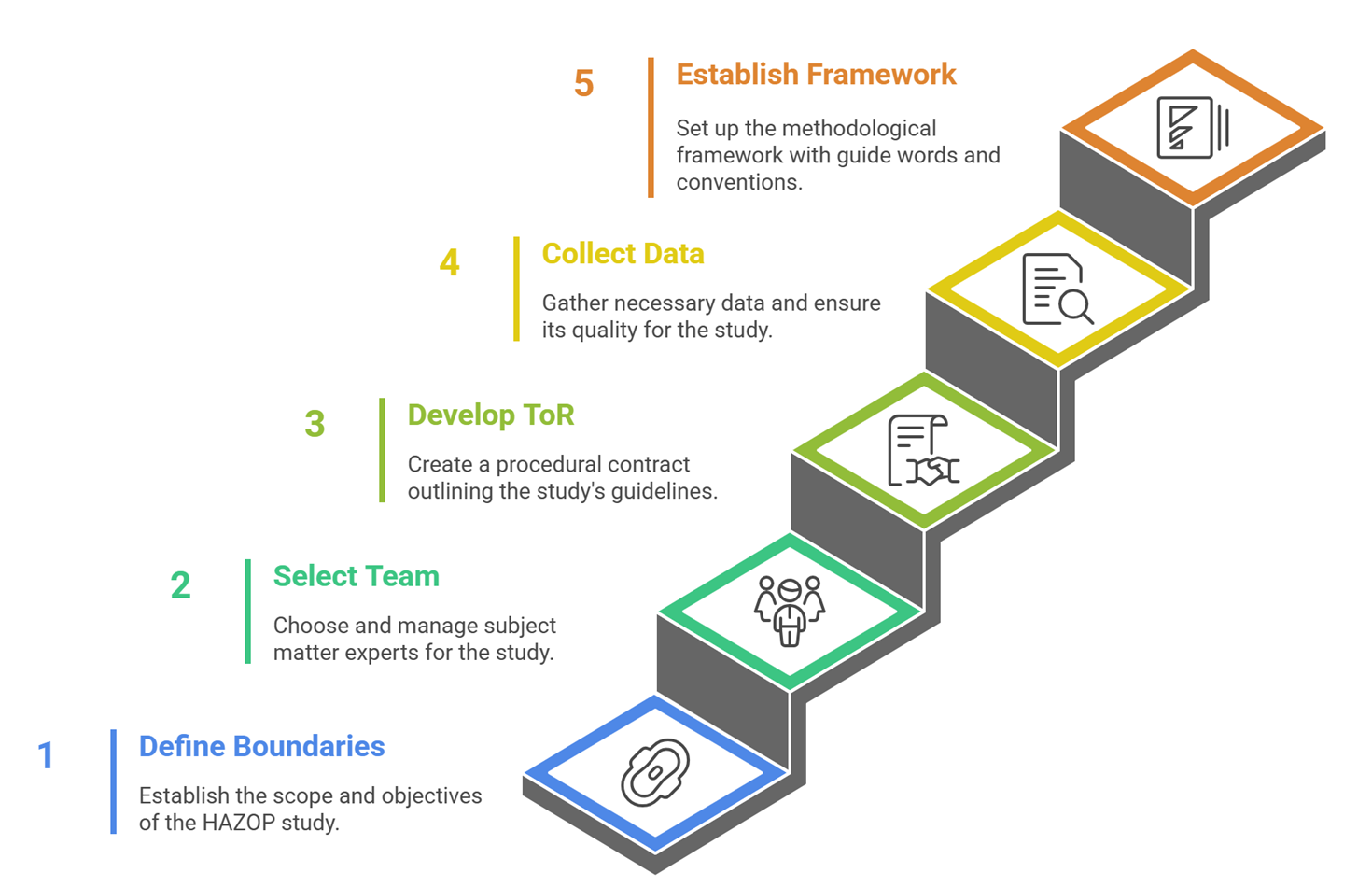
2.1. Defining Study Boundaries, Scope, and Objectives
The preparation phase commences with the Definition Phase, where the facilitator must delineate the scope and objectives of the assessment. This involves carefully identifying study boundaries, key interfaces, and the underlying assumptions that will govern the entire assessment.
By clearly defining the assessment scope and objectives early on, the facilitator ensures that the team’s efforts are appropriately focused. This focused scope provides the facilitator with the necessary authority during the workshop to decline review of tangential issues or design elements that fall outside the agreed-upon criteria, such as only HAZOP-ing sections of P&IDs that have been modified. This enforcement capability is vital for maintaining project schedule integrity and preventing unnecessary scope creep.
2.2. Team Selection and Management of Subject Matter Experts (SMEs)
The facilitator is responsible for selecting the appropriate cross-functional team. This team relies on subject matter experts (SMEs) drawn from various disciplines, including process/chemical engineering, operations, and process controls/instrumentation engineering, all of whom must possess current knowledge and relevant experience.
Team selection is intrinsically linked to quality control. The facilitator must ensure the team is quorate—meaning all necessary technical domains are represented. This includes ensuring sufficient knowledge of human factors concepts, which is critical for scrutinizing safeguards dependent on human intervention. Beyond selection, the facilitator is responsible for ensuring the team is properly prepared, which often involves distributing briefing notes, the Terms of Reference (ToR), and any prerequisite data, ensuring attendees are up to speed prior to the workshop commencement.
2.3. Developing the Terms of Reference (ToR): The Procedural Contract
The Terms of Reference (ToR) serves as the formal procedural contract for the HAZOP study. The facilitator must prepare or give substantial input to the ToR and ensure its distribution to all participants at least one week prior to the workshop.
The ToR must explicitly detail the agreement between participants on how the HAZOP will be conducted. This includes describing the specific methodology to be used, the nodes chosen for review, the set of guide words applicable to the process, the complete participant list, and the agenda for the sessions. By formally defining the methodology and the specific guide words in the ToR, the facilitator preempts procedural disagreements during the high-pressure execution phase. The document acts as a binding contract, empowering the facilitator to strictly enforce procedural rigor and structure when discussions become circular or lose focus.
2.4. Data Collection and Prerequisite Assurance (P&ID Review and Data Quality)
Preparation mandates planning the study and collecting all necessary supporting data and information. A vital preparatory task for the facilitator is ensuring that the Process and Instrumentation Diagrams (P&IDs) used for the HAZOP contain a minimum number of drawing errors or minor issues.
This proactive assurance of P&ID quality is a key guardrail for resource optimization. The multi-disciplinary team, representing high-value expertise, should not be diverted to correcting basic documentation flaws. The facilitator ensures the team’s focus remains exclusively on the sophisticated task of hazard identification, minimizing distractions that could compromise the intellectual flow of the session. If drafting errors are identified during the preparatory or early review process, the facilitator must mark the corrections and ensure they are duly noted in the minutes.
2.5. Establishing the Methodological Framework: Guide Words and Recording Conventions
Prior to the commencement of the workshop, the facilitator must reach consensus with the client or team on the specific HAZOP guide words to be used during the study. Simultaneously, the style of recording must be agreed upon. This often involves defining the specific risk software that will be utilized for efficient data capture, such as PHA-Pro or a similar system.
Standardizing recording conventions and agreeing upon the template format ensures consistency in the output data. This consistency is critical for subsequent risk review activities, such as Layer of Protection Analysis (LOPA) screening or database archival. The facilitator establishes the quality requirements for this documentation, setting the stage for auditable and traceable results.
Table 1 details the necessary organizational elements established during the Definition and Preparation Phases.
Table 1: Key Elements of the HAZOP Terms of Reference (ToR) and Facilitator Accountability
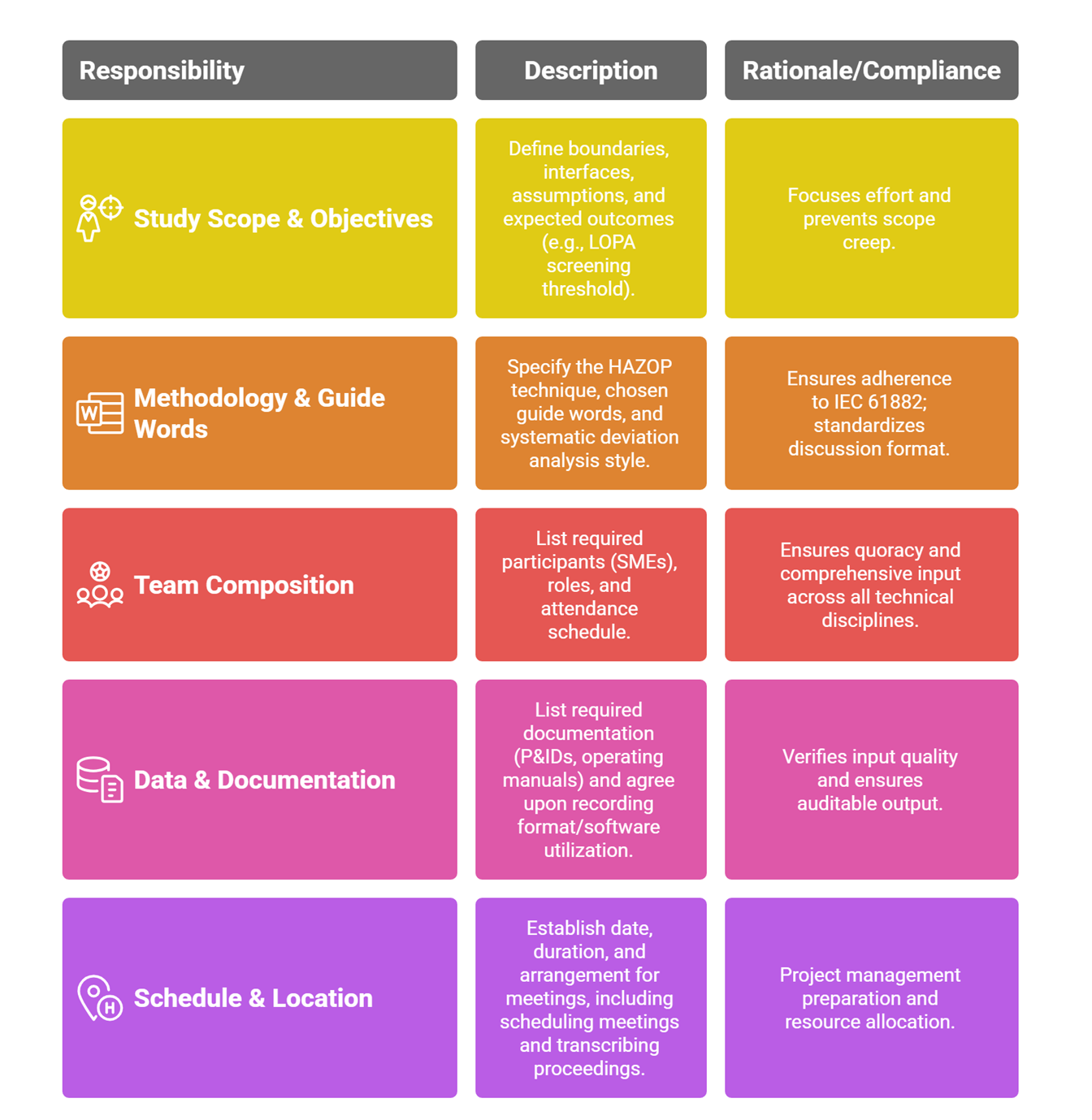
Section 3: Phase II – Workshop Execution and Procedural Management
During the execution phase, the facilitator transitions into a proactive process controller, managing the delicate balance between intellectual rigor, schedule adherence, and the psychological dynamics of the multi-disciplinary team.
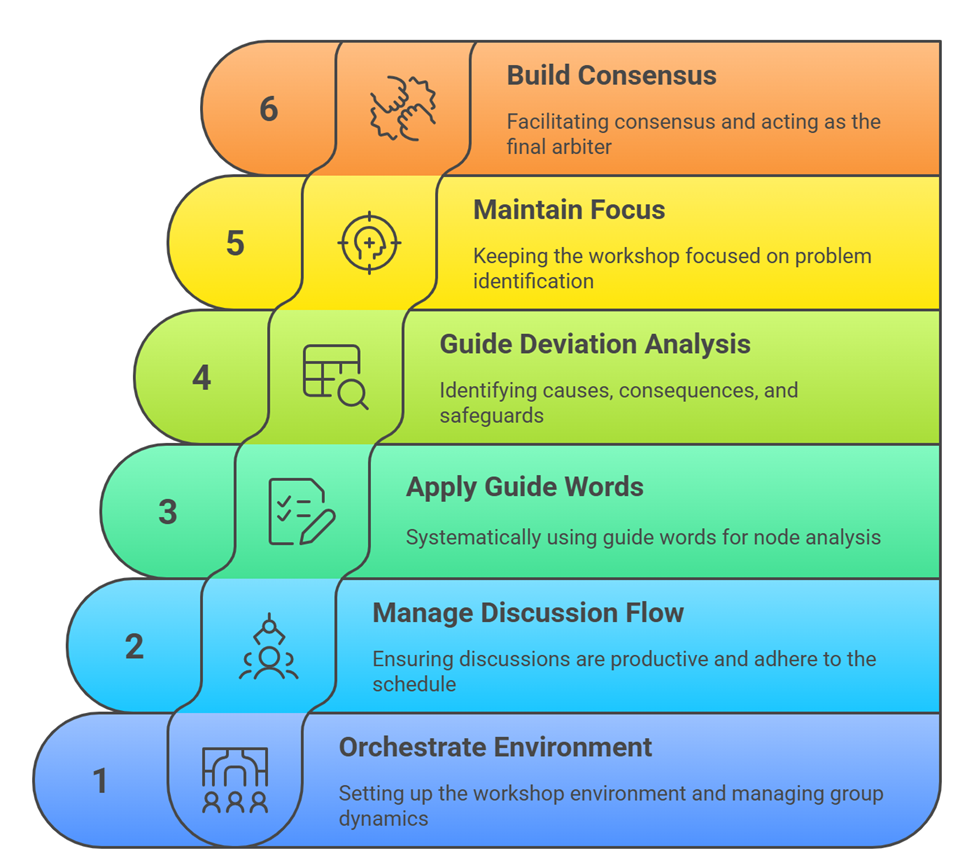
3.1. Orchestrating the Workshop Environment and Group Dynamics
The facilitator is tasked with ensuring optimal group dynamics. This involves managing conflicts, accommodating diverse personalities, and ensuring that the collective knowledge of the team is efficiently drawn out and processed. Crucially, the facilitator must maintain objectivity and independence, preventing the study’s conclusions from being unduly influenced by a single, forceful, or outspoken team member.
The facilitator must explicitly ensure that all parties are actively contributing and prevent the facilitator or a single dominant SME from dictating hazards or actions without the participants’ acceptance. This environment cultivates the psychological safety necessary for frank discussion and critical analysis.
3.2. Management of Discussion Flow and Adherence to Time/Schedule
Maintaining control over the pace and structure of the discussion is key to maximizing cognitive efficiency. The facilitator must enforce procedural ground rules, specifically ensuring that only one conversation occurs at a time. They must actively provide direction, keep the meeting on track, and know when to allow latitude for necessary depth or when to intervene and cut a speaker short to adhere to the schedule.
By rigorously enforcing these ground rules and managing the clock, the facilitator minimizes distractions and parallel processing, ensuring the highly compensated team maintains focus. This disciplined control over discussion velocity directly translates into maximum analytical output per hour of review, a fundamental measure of study efficiency.
3.3. Systematic Application of Guide Words and Node Analysis
The facilitator is the keeper of the HAZOP methodology during execution. They lead the team through the systematic process of dividing the system into parts, selecting a part (node), and defining its design intent. They must then systematically apply the pre-agreed guide words to the selected node.
The facilitator refers the team to the next guide word only when the current one requires no further consideration. This enforcement of procedural rigor is paramount, as the main advantage of HAZOP is its systematic thoroughness in failure case identification. The facilitator ensures the team rigorously checks every potential deviation, guarding against the impulse to skip over scenarios based on perceived probability.
3.4. Guiding Deviation Analysis: Causes, Consequences, and Safeguard Identification
The facilitator guides the team through the core analysis steps for each identified deviation: identifying possible causes, determining consequences, and identifying existing protection, detection, and mitigation mechanisms (safeguards).
During consequence analysis, the facilitator must guide the team to determine the worst-case consequence that does not consider existing safeguards. This is a critical risk control mandate. By enforcing the initial disregard for safeguards, the team is forced to identify the true maximum credible event, including Major Accident Hazard (MAH) potential, adhering to the principle that no safeguard is 100% effective. The facilitator ensures this level of rigor to prevent the potential underestimation of risk severity.
3.5. Maintaining Focus: Finding Problems vs. Defining Solutions
The central aim of the workshop is to find problems that require a solution, rather than designing the solution itself. The facilitator must intervene if the team becomes mired in the technical resolution of a complex problem.
It is considered best practice to defer consideration of unsolved problems to a later date, allowing the study to proceed efficiently to the next node. The facilitator’s action here is to capture the problem clearly and mandate a formal action item for subsequent engineering review. This procedural control preserves the distinction between identification (the HAZOP purpose) and resolution (the engineering follow-up), ensuring that the high-value time of the multi-disciplinary team is used strictly for comprehensive identification.
3.6. Consensus Building and the Role of the Facilitator as Final Arbiter
The facilitator’s style should be facilitative, avoiding domination of the discussion or dictating hazards or actions without participant acceptance. They must draw out the collective knowledge and experience of the team.
However, the team may occasionally reach an impasse where consensus cannot be achieved, often due to differing technical opinions on probability or consequence. In such instances, the facilitator is empowered to act as the final arbiter. This authority is a necessary procedural fail-safe to prevent study deadlock. When exercising this authority, the facilitator must rely on their expertise in risk management methodology and the tenets of the ToR, rather than personal technical preference, ensuring the decision upholds the integrity of the process.
Section 4: Essential Competencies of the Expert Facilitator
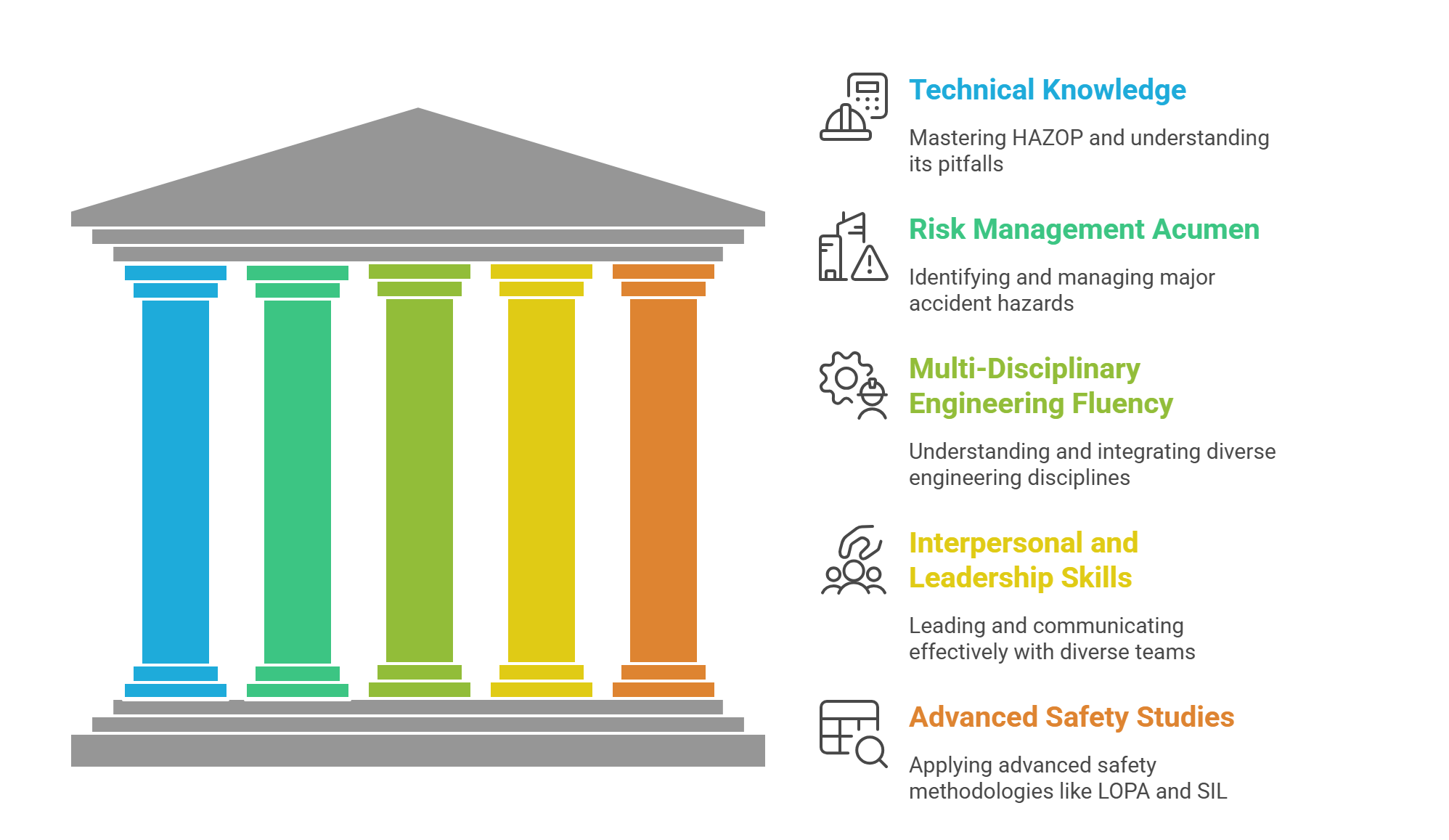
The competence required of an expert HAZOP facilitator is diverse and multifaceted, synthesizing technical understanding, risk management expertise, and advanced interpersonal skills. This unique blend allows the facilitator to be effective as both a leader and a process manager.
4.1. Mastering the HAZOP Methodology and Pitfalls (Technical Knowledge)
The facilitator must serve as the foremost expert in the room regarding the HAZOP method and the associated risk principles. This includes a thorough understanding of the methodology’s potential pitfalls, as overlooking these can have significant repercussions for the entire risk management process.
Methodological mastery acts as the primary internal quality assurance mechanism. It allows the facilitator to identify subtle procedural errors or faulty deviation linkages during the session, ensuring the integrity of the risk assessment before it progresses to documentation.
4.2. Risk Management Acumen: Major Accident Hazards (MAHs) and Worst-Case Scenarios
A competent leader must understand the relationship between process safety studies and the effective control of Major Accident Hazards (MAHs), including the relevant regulatory context and good practice drivers. This acumen informs the discussion on consequence severity, particularly the requirement to identify the worst-case potential.
A vital aspect of this role is the capacity for informed skepticism—the leader must know what they do not know, and critically, identify areas where the team’s collective knowledge might be deficient. This capacity allows the facilitator to challenge assumptions and ensure that meaningful actions, such as gathering supplementary data or performing additional calculations, are raised only when necessary, rather than being dismissed prematurely.
4.3. Multi-Disciplinary Engineering Fluency
While the facilitator does not need to be the deepest expert in every technical field, they must possess a grounding in multi-disciplinary engineering principles. This enables them to converse effectively in several “languages,” including process, chemical, instrumentation, operations, safety, and human factors.
This fluency is essential for synthesizing the multi-disciplinary output and asking targeted, challenging questions. For example, the facilitator must be sufficiently versed to scrutinize the feasibility of human intervention safeguards, challenging scenarios where performance shaping factors (like extreme temperatures or required travel distance) might compromise an operator’s ability to act. The ability to synthesize knowledge allows the facilitator to build holistic, integrated risk scenarios, connecting a process deviation to a control system failure and a subsequent human error.
4.4. Advanced Interpersonal and Leadership Skillsets
The primary function of running the workshop effectively hinges on advanced interpersonal and leadership skills. This includes the ability to listen intently, interpret complex technical discussions accurately, provide clear direction, and manage conflicts constructively. The facilitator must ensure that team members contribute within their designated area of expertise, challenging the room when necessary to maintain rigor, and working closely with the scribe to record accurate notes and adhere to the schedule.
The expert facilitator employs a dual skillset, understanding when to apply directive leadership (enforcing structure, adhering to the schedule, and arbitrating procedural issues) and when to use a purely facilitative approach (drawing out collaboration and technical depth). This nuanced application of authority is essential for navigating technical disputes while maintaining productivity.
4.5. The Bridge to Advanced Safety Studies (LOPA, SIL Determination, and Effectiveness Evaluation)
Modern process safety mandates that HAZOP not exist in isolation. The facilitator needs familiarity with Layer of Protection Analysis (LOPA) and Safety Integrity Level (SIL) requirements. HAZOP forms an indispensable bridge between qualitative process safety studies and quantitative functional safety requirements.
The facilitator ensures that the qualitative findings from the HAZOP are adequately structured to serve as inputs for subsequent LOPA studies. They may use LOPA principles during the HAZOP itself to evaluate the preliminary effectiveness of identified safeguards. This forward-looking competency ensures continuity in the risk management process, establishing a path from hazard identification to the rigorous, quantitative verification of required protection layers.
Table 2 summarizes the critical domain competencies required for expert facilitation.
Table 2: Required Multifaceted Competency Matrix for a HAZOP Facilitator
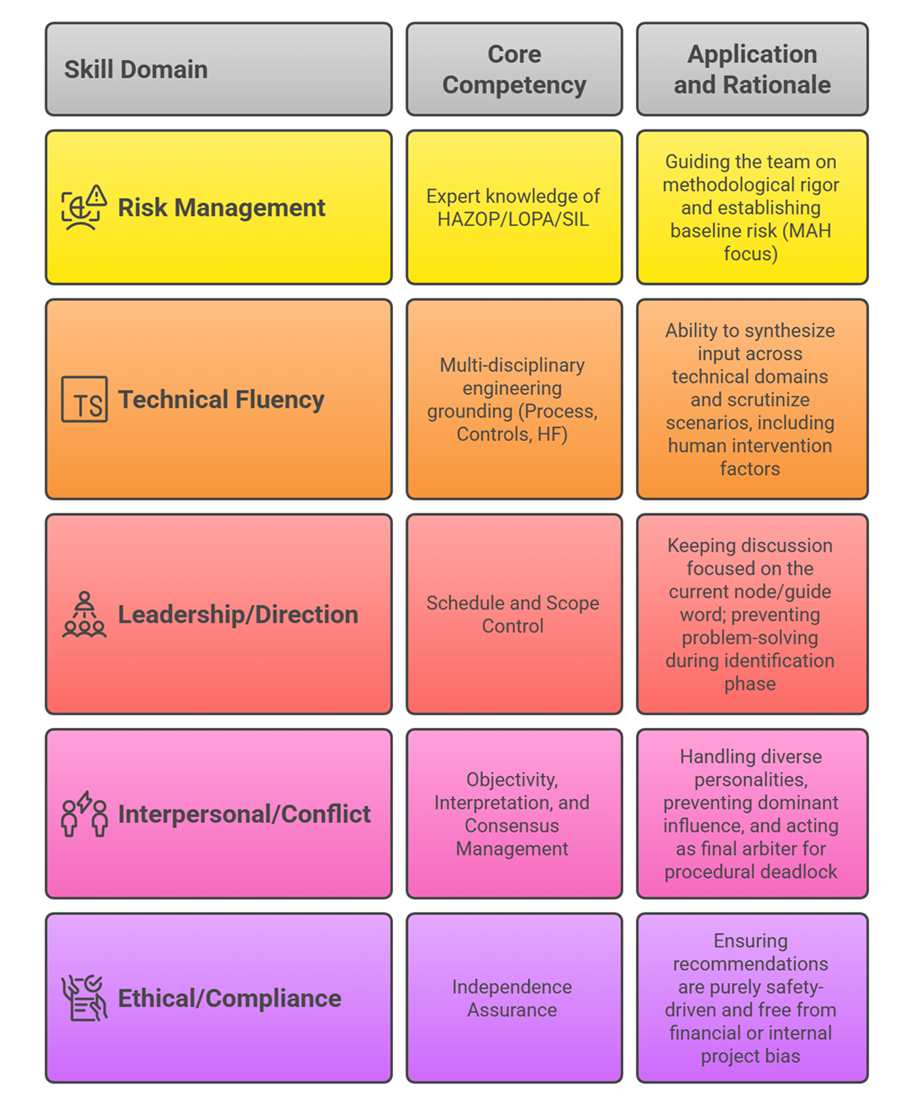
Section 5: Phase III – Documentation, Action Management, and Review
The final phase of the HAZOP study transforms the transient intellectual discussion into a permanent, verifiable record of due diligence and mandated corrective actions. The facilitator retains ultimate oversight of this critical transition.
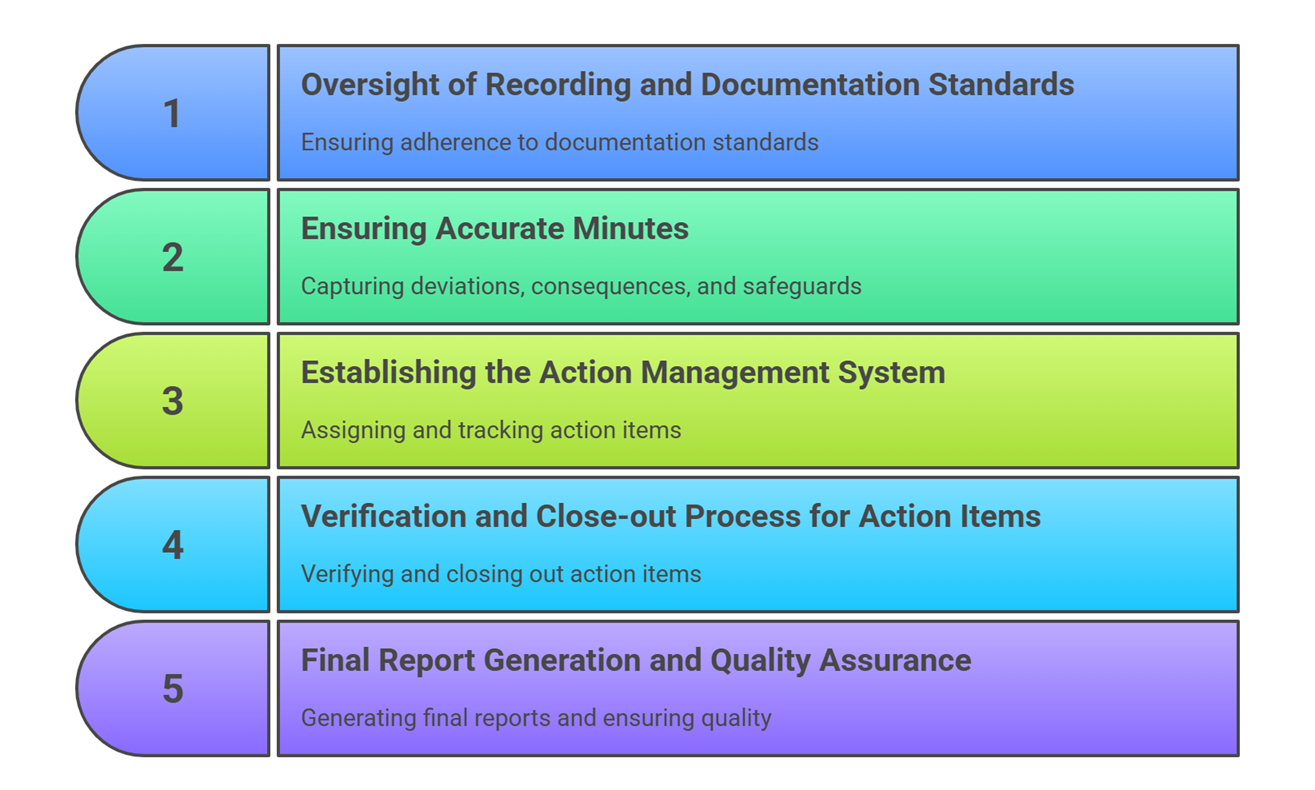
5.1. Oversight of Recording and Documentation Standards
The facilitator is ultimately responsible for ensuring that all findings from the study are documented competently. The documentation, which may utilize specialized risk software for efficient capture and presentation, must include the executive summary, the date and time of the study, attendees, critical scenarios uncovered by safeguards, and all identified deviations, consequences, and required actions.
While the scribe handles the actual recording, the facilitator sets the documentation standards. The final report structure should minimize administrative burden by focusing on issues requiring attention, which is often accomplished through “reporting by exception”. This approach ensures the documentation is cohesive and suitable for regulatory scrutiny and auditable confirmation of due diligence.
5.2. Ensuring Accurate Minutes: Capturing Deviations, Consequences, and Safeguards
The chairperson must ensure that all decisions taken during the review are accurately minuted. If changes are agreed upon at the meeting, they must be marked on the P&ID or layout and noted in the minutes.
A specific procedural mandate is that the recording of existing safeguards must be retained, even in cases where no further action is required for a particular scenario. This requirement establishes the safety baseline. By explicitly documenting all existing protection layers, the facilitator prevents the potential for subsequent, undocumented removal of these safeguards during future Management of Change (MOC) processes, thereby guarding against the degradation of the established safety foundation and ensuring that assumptions about the level of residual risk remain valid.
5.3. Establishing the Action Management System: Assignment and Tracking
The facilitator must ensure that appropriate actions are developed to control or mitigate the identified hazards. Critically, an effective action management system must be established to track the progress of implementation. Each assigned action requires a unique tracking number, a defined outcome, and a clear assignee.
The facilitator initiates the accountability chain by ensuring that copies of the minutes and action assignments are promptly forwarded to the individuals responsible for resolution. This system bridges the operational gap between the hazard identification workshop and the physical execution of safety improvements, transforming recommendations into verifiable, scheduled tasks.
5.4. Verification and Close-out Process for Action Items
The responsibility of the facilitator extends beyond mere assignment; they must regularly review the progress of action implementation. The facilitator is accountable for verifying that a robust process exists to ensure all assigned actions are closed in a satisfactory manner. The outcome or resolution recorded by the responsible person must be forwarded to the facilitator or the person monitoring the study.
This close-out verification confirms that the implemented solution genuinely meets the original risk reduction intent, not just an administrative requirement. All action items or recommendations must be fully closed out by the end of the project lifecycle to certify the final residual risk profile of the operating system.
5.5. Final Report Generation and Quality Assurance
The final report documentation must be commensurate with the nature of the risks assessed and align with individual company documentation policies. The facilitator ensures the final document is structured, including a clear executive summary and general comments, and defines the necessary level of recording. This final quality assurance step ensures that the report is a cohesive, auditable document, ready for integration into corporate risk registers and suitable for regulatory submission.
Table 3 details the facilitator’s mandated activities throughout the crucial Action Item Lifecycle.
Table 3: HAZOP Action Item Accountability Lifecycle
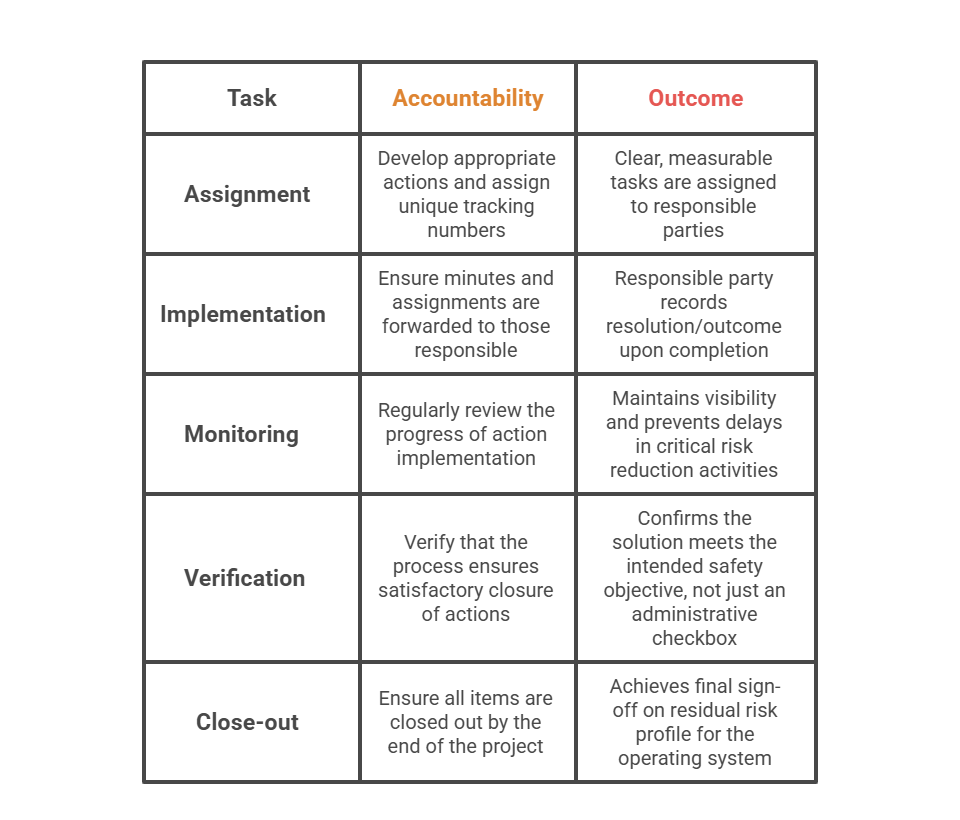
Conclusions
The role of the HAZOP facilitator is one of integrated process control, methodological expertise, and ethical stewardship. Their responsibilities span the strategic definition of the study, the rigorous execution of the systematic analysis, and the critical post-session management of corrective actions.
The mandate for independence is the single most defining characteristic of the facilitator, guaranteeing that the identification and mitigation of hazards are driven solely by safety considerations rather than internal financial or design constraints. Furthermore, the facilitator’s expertise must be comprehensive, bridging qualitative risk identification with quantitative safety verification (LOPA/SIL) to ensure continuity across the entire risk management lifecycle.
Ultimately, the facilitator transforms a collaborative brainstorming exercise into a structured engineering assessment by enforcing procedural controls (like the ToR and guide word application) and maintaining strict discipline (such as focusing on problem identification over resolution). By meticulously overseeing the documentation, including the mandatory retention of safeguard records, the facilitator ensures the organization establishes a verifiable safety baseline, effectively manages residual risk, and creates an auditable chain of accountability for all required safety improvements.

Estou interessado em participar